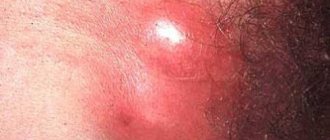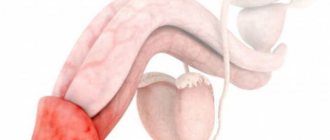The condition when a girl itches in her intimate area and really wants to scratch between her legs endlessly is familiar to almost everyone. But the burning and itching in the perineum and genital area is especially unbearable. And it’s not just about the rules of decency, which do not allow a person to ease the situation even for a while. The part of the body “below the waist” is very rich in nerve endings, and itching in the groin brings incomparable suffering. Women, encountering these sensations for the first time, almost always experience stress, as they are associated with something indecent, primarily with sexually transmitted infections...
Until now, medical science cannot clearly explain what intimate itching is. In women, apparently, this sensation appears due to very weak irritation of the nerve endings, which cannot cause “full” pain. And, oddly enough, quite serious ailments can be hidden behind this “trifling” ailment.
Why are itching and burning dangerous?
Due to unbearable sensations, a woman sometimes cannot work, refuses to relax with friends, or intimate intimacy with her partner. Other problems accumulate like a snowball: self-doubt, irritability, insomnia. However, these are not the worst complications.
Itching and burning in themselves sometimes indicate dangerous pathologies that threaten dysfunction of the genitourinary system. If the problem is related to vaginal dryness, then bacteria and other microorganisms will quickly accumulate in the microcracks that appear, so several more will be added to the main pathology.
Why does your intimate area itch?
The most common causes of vaginal itching include general or local inflammatory and infectious processes, various allergic reactions, as well as structural changes in the tissues of the genital organs during the decline of hormonal function in patients who have entered menopause.
The skin and mucous membranes of the vulva and vagina are supplied with a large number of nerve endings. They are located shallowly in the groin area and easily respond to any mechanical or chemical impact of external or internal factors. The feeling of moderate to severe itching between the legs is a reaction to such irritants. Its intensity varies widely: a girl may occasionally be bothered by only a slight itching in the vagina and/or the skin of the external genitals, and sometimes it becomes constant, unbearable and forces her to urgently seek help from a gynecologist.
Indeed, in girls and young women, the most common causes of itching in the labia and vagina are genital infections and sexually transmitted diseases, which cause inflammation of the mucous membrane - colpitis and vulvitis. Such diseases are accompanied by pathological discharge (leucorrhoea); they contain a large number of pathogenic bacteria, the waste products of which irritate the mucous membrane and cause itching in the vagina and groin.
Moreover, it should be borne in mind that the intensity of itching in intimate places is not a valuable criterion for determining the nature and severity of the disease. This refers to the subjective feelings of the girl herself and depends on the individual parameters of the reaction of her skin and mucous membranes to irritants.
In postmenopausal women, slight itching in the vulva is accompanied by a feeling of dryness or burning. The decrease in vaginal discharge in this age group is associated with physiological reasons - a gradual decrease in hormonal levels, and primarily estrogen hormones. The vaginal mucosa looks atrophic (thin and pale), there is very little discharge - it is easily injured by any external influence and does not cope well with local inflammation.
Other causative factors for such annoying sensations may be:
- HPV and condylomas,
- vaginal dysbiosis,
- kraurosis and leukoplakia,
- diabetes,
- violation of intimate hygiene,
- hormonal disorders,
- liver diseases,
- urethritis and urethral papilomatosis,
- allergic reactions,
- worms and parasites.
Moreover, all these manifestations occur not only in adult women who are sexually active. Virgin girls, children and teenagers can also itch in the intimate area.
Intimate itching in a girl
Vulvovaginitis in children 10-11-12-14 years old is an inflammatory process in the area of the external genitalia and vagina, which is most common in childhood and adolescence. The main signs of inflammation of the vulva in girls and adolescents are vaginal itching, discharge from the genital tract, redness, burning and pain when urinating. Sometimes these symptoms are sluggish, the child periodically scratches in an intimate place. What should mom do in this case? Without delay, visit a pediatric gynecologist and get tested.
If you do not pay attention to all this in time, complications are inevitable - with a long course of vulvitis, it can contribute to the formation of synechia (fusion of the right and left labia with each other), the formation of polyps, papillomas of condylomas in intimate places, cicatricial changes in the vagina. One of the serious consequences of itching and burning in teenage girls is synechia (sticking together) of the walls at the vaginal opening, atresia (fusion of the hymen) and subsequent, with the onset of menstrual function, the formation of hematocolpos.
Intimate itching during pregnancy
The most common cause of itching in the intimate area in pregnant women is vaginal candidiasis. It is an inflammatory process of the mucous membranes caused by an overgrowth of a fungal infection (Candida fungi) in the vagina. The provoking factor is a physiological decrease in the number of lactobacilli due to changes in hormonal levels. Thrush occurs three times more often during pregnancy, is important in obstetric practice and requires mandatory elimination.
If we talk about specifics, then expectant mothers will be told by their obstetrician-gynecologist who monitors the course of pregnancy about how and how to treat intimate itching.
Diagnostics
If a man or woman has itching in the intimate area, testing for hidden infections is the first thing to do before starting treatment.
Minimum requirements: Gynecological examination, smear for flora, PCR tests for infections, bacteriological culture for flora, general urine test.
Tests according to indications: Since the vagina and labia can itch for reasons unrelated to infectious or sexually transmitted diseases, the range of tests for intimate itching can be expanded. Thus, a gynecologist can prescribe tests such as colposcopy, cervical smear cytology, blood tests (hormones, allergens, biochemical, general analysis), ultrasound of the pelvic organs.
Diagnosis of causes
First, the doctor will conduct a gynecological examination on a chair to understand the extent of the lesion and the localization of the pathological process. To obtain a more informative result, doctors perform colposcopy - studying the inner surface of the vagina using an optical device that magnifies the image 50-60 times. At the same stage, smears are taken from the patient for microflora and cytology.
Further laboratory blood tests or urine tests are required. It is important to find out the presence of an inflammatory process, the source that led to it (allergen, bacteria, viruses, fungi, hormonal disorders).
To obtain a complete picture of the pathology, the gynecologist performs an ultrasound of the pelvic organs, especially if the patient complains of pain in the lower abdomen or other symptoms. The study helps to determine more precisely the localization of the process and the affected internal tissues. It may be possible to identify foreign bodies or neoplasms that cause itching or burning.
Treatment of intimate itching
If you have discharge, itching and itching in an intimate place inside or outside, or other discomfort, do not delay solving the problem! To establish the cause and get rid of the disease, not much is needed ⇨ it’s to make an appointment with a gynecologist and undergo a full diagnosis. Our doctor will conduct an examination and the necessary examination, based on the results of which effective treatment will be prescribed.
Tests for itching in the intimate area
Tests will help you find out why the intimate part of a woman, a young girl, including a virgin, as well as teenagers and younger girls itches. Depending on the age of the patient, the complaints made and the result of the examination of the genitals on the chair, to clarify the cause of the itching, the gynecologist may prescribe something from the following list of tests:
- Flora smear
- PCR for hidden infections
- Bacterial seeding of discharge
- Florocenosis analysis
- Blood for hormones
- Blood for some infections
- Blood chemistry
- Scraping for oncocytology
Treatment of discomfort in the intimate area
The content of the therapy program depends on the identified cause of the pathology and the degree of its spread. For STDs, antibacterial and antiviral treatment is prescribed. In case of hormonal disorders, the functioning of the endocrine glands is corrected. If the unpleasant symptoms are caused by the spread of genital warts, they are removed using a laser, radioknife or cryotherapy. In this case, it is necessary to take antiviral drugs.
Symptomatic treatment is reduced to taking anti-inflammatory, antihistamine and diuretics. The products help relieve swelling and restore natural metabolism. It is possible to prescribe injections, tablets and local remedies: sprays, suppositories, douching solutions.
During the treatment period, a woman must maintain intimate hygiene using the products recommended by the doctor. It is also necessary to stop wearing synthetic underwear, giving preference to underwear made from natural fabrics.
2. Reasons
The first thing that comes to mind is basic hygiene. However, we are not just talking about uncomfortable sensations or the need for cleanliness, but about a painful, imperative (imperative) or compulsive (irresistible) urge to itch, and even if you do not visit the bathroom for years, it is hardly possible to bring yourself to such a state.
Itching is caused by moderate or weak, but continuous irritation of the nerve endings. This specific effect can be caused by a variety of physical, chemical, biological and even mental factors.
In particular, the skin can be irritated by accidentally falling small sharp particles (dust, sand, fiberglass, microscopic plant thorns, etc.), friction from synthetic, too tight or other poorly purchased underwear, and thermal damage.
Equally aggressive towards the skin nerve endings are certain groups of chemical compounds, including those contained in the saliva of stinging or blood-sucking insects (it is no coincidence that one of the intradermal mites that can parasitize on the human body is called “itchy itch”), as well as in caustic sap of some plants.
In addition, intense itching is a typical symptom of many dermatological and endocrine diseases (eczema, lichen, psoriasis, diabetes, autoimmune-allergic disorders, all kinds of dermatitis, etc.).
Paresthesia (false sensations of “pins and needles”, “crawling insects” and, in particular, scabies or itching) are found in the clinical picture of a number of mental disorders and psychopathological reactions, as well as organic lesions of the central nervous system.
Finally, one of the most common causes is infection of the perineal skin (especially if there are abrasions or microcracks) with bacterial, viral or fungal cultures.
Itching in the perineum in men and women, despite all the anatomical and physiological differences, has no fundamental etiopathogenetic specificity; it is caused by the factors listed above, as well as STDs (sexually transmitted diseases), hemorrhoids, and anal fissures. The likelihood of an allergic reaction to household chemicals and personal hygiene products, medications, herbs, latex, etc. does not depend on gender. As for “itchy” infectious and inflammatory processes, sexual dimorphism corrects only the localization of the lesion (vaginal dysbiosis, balanitis, adnexitis, prostatitis, etc.), while the mechanisms of biotoxic damage to nerve endings and irradiation of itching to the perineal area are universal .
Visit our Gynecology page










